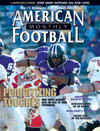AMERICAN FOOTBALL MONTHLY THE #1 RESOURCE FOR FOOTBALL COACHES
Article CategoriesAFM Magazine
|
The Speed Report: In Season Conditioning: Specificity is Key for Game Enduranceby: Dale BaskettFootball Speed Specialist by: Mike Johnson Sports Science Consultant © More from this issue Well, we’ve developed off season speed. Now how does it hold up during the season demands? Put on the pads and let’s go through the physical parameters of the body busting hell. Will he endure with the same speed and efficiency that off season was developed in shirts and shorts and no physical pounding? No! Why do you think that the world-class sprinters have not made a great impact in the NFL over the years? The demands of football’s pounding nature doesn't lend itself to the infinite precision that the world class sprinter experiences daily! Football requires absorbing bruises, blows and joint pain constantly. If a thoroughbred track sprinter absorbs that kind of abuse, he wouldn’t be very fast. Speed is Key But Suffers During the Season High contraction effectiveness relies on high inten....The full article can only be seen by subscribers. Subscribe today!
|
|
|||||||
| HOME |
MAGAZINE |
SUBSCRIBE | ONLINE COLUMNISTS | COACHING VIDEOS |
Copyright 2025, AmericanFootballMonthly.com
All Rights Reserved





